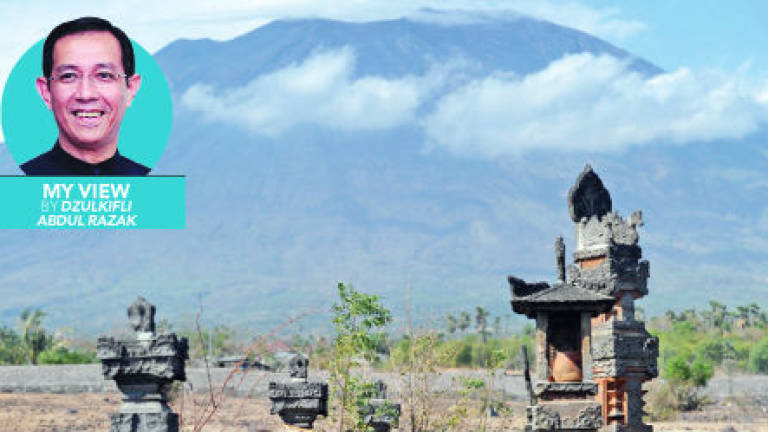'Sejahtera' thrives in Bali

MY maiden trip to Bali (the island of gods) last week was not an easy one. The famous Mount Agung, located in the eastern part and is the island's highest (3,014m) active volcanic peak, had been rumbling a few weeks before. Many recalled what it was like in 1963, when everyone was on high alert. After all, it is the sacred abode of the gods.
When the governor reportedly declared a state of emergency just days before the trip, the situation seemed to be anything but "sejahtera". It made me very anxious as I was to deliver a keynote address on the Balanced Leadership concept of "Sejahtera" – an age-long indigenous lifestyle that well preceded what is today known as "sustainable development" (SD).
Initiated in 1987, SD has been recognised for a good 30 years now. It has done well but could be better if the indigenous perspective is also considered. Given that indigenous knowledge and wisdom has gained sufficient credence globally as a viable and "living" knowledge system, I aimed to rework the SD by leveraging on the wide acceptance of indigenous knowledge, in order to fill in the "gap".
The modern knowledge system has failed to exude the much needed wisdom in its quest for a more sustainable future. Its long-standing prescriptive, technologically-prone and bureaucratic, if not western-centric version has marginalised the local socio-cultural context, and neglected to learn from local traditions of yesteryear.
So I was pleasantly surprised to find out that the "Sejahtera" concept is well encapsulated in Balinese traditions too. Locally known as Tri Hita Karana (THK), it dates back many centuries to embed "the three causes of well-being" (read: Sejahtera) and forms the basis of Balinese way of life and philosophy of living.
First, it affirms the sacred relationship between humans and the gods; also between and among fellow humans; and lastly that of humans and nature or the natural ecosystem. Collectively, it enriches and broadens the three aspects of SD that essentially focuses on the material aspects of the last two sans the spiritual imperatives as the Balinese understand it.
However, THK resonates very closely with the concept of "Sejahtera", which has an added fourth dimension of relating human to the "self".
Regardless, there are ample commonalities being forged by the two cultures of the Nusantara, if not Asean more generally. Some even consider it as universal, cutting across all forms of boundaries akin to that of "Sejahtera". With the coming together of the Asean community in 2015, a common bridge anchored on positive values of "Sejahtera" and THK will go a long way to redefining what the "community" must do to vibrantly stay harmonious and balanced.
This is clearly evident in Bali from the panoramic padi (rice) fields that stretch as far as the eyes can see forming the subak, which is the community of farmers who work collaboratively to ensure that harmony with nature is kept cardinally (though not structurally). In a sense, it is said to be autonomous (democratic) and free to organise within the natural limits defined hydrologically; unlike that of a village with rigid "administrative" borders. The subak system follows closely the stepwise hill contours beginning from the upstream water source(s) in the form of a "lake" (subak agung) leading to a river, canal and eventually the rice field. Each plot of the subak has an inlet and outlet to allow the water to flow downstream. In this way, the interplay between each part of the subak system is well balanced and "sejahtera". So too, indeed, between the subak and villages adjacent to it.
All these ascertain that the relationships between and among humans as well as nature and the gods are always alive as noted by former president Susilo Bambang Yudhoyono when citing the subak during his address at the 2013 International Conference on SD, held on the enchanted island, the year before the subak was added to Unesco World Cultural Heritage list.
In terms of spiritual relationship, it is symbolised by water temples (pura) usually erected upstream where the water source(s) naturally originates but not limited to it. They give the rice fields a sacred aura – with rice regarded as a gift from the gods. At the same time it acts as a socio-cultural glue, connecting and bringing the communities even closer. Functionally subak serves, among others, as a platform for conflict resolution, inclusive ritual and religious activities, sharing of resources apart from water, to include rice and finances too. This in turn further enhances the cultural glue by building trust, norms, networks, as well as a biosphere reserve based on balanced relationships in all aspects enumerated above.
Succinctly, it is about ensuring that "Sejahtera" thrives as nurtured by THK.
Like THK, the "Sejahtera" concept is regarded as vital for the purposes of maintaining a harmonious balance within the larger societal framework as its primary thrust. This is done by sustaining the (micro) balance between each of the 10 elements that make up "Sejahtera" as summed up by the acronym SPICES – spiritual, physico-psychological, intellectual, cognitive, cultural, ecological, ethical, emotional, economics and societal. While part of the conventional SD pillars are included, it goes beyond that to embrace THK too.
That being said it is noteworthy that the fate of rice fields at home remains largely uncertain due to the rapid onslaught of (unsustainable) development. While we were told recently that the country is 80% self-sufficient in rice, the question that must be raised: Are we any closer to being harmoniously balanced since our rice bowl state has rightly adopted "Kedah Sejahtera" as it tagline?
With some four decades of experience in education, the writer believes that "another world is possible". Comments: letters@thesundaily.com